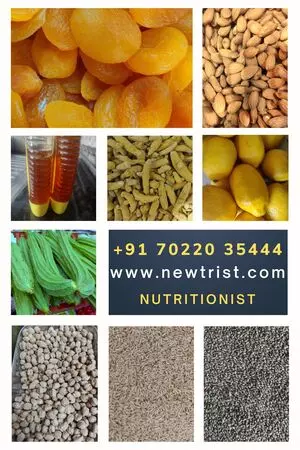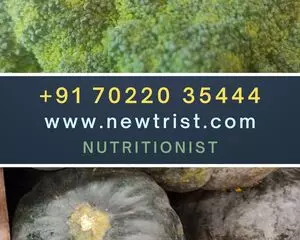Newtrist Nutritionist Erythema Nodosum Diet Plan consists of a healthy balanced diet devoid of any inflammatory foods. A wide range of fruits, vegetables, whole grains, beans, legumes, nuts, seeds, and lean meats such as skinless chicken, fish, and eggs are some of the best foods to include for Erythema Nodosum.
- Early morning drink @ 6:30 am: Apple cider vinegar drink
- Breakfast @ 9 am: Vegetable-stuffed bread (whole wheat bread) pockets
- Mid-morning meal @ 11 am: Broccoli-Avocado salad
- Lunch @ 1 pm: Brown rice with Pumpkin dal and any seasonal fruit
- Evening snack @ 4 pm: Green tea and spicy bhel
- Dinner @ 7 pm: Grilled mushroom with tossed vegetables
Best Nutritionist in Bangalore
Consult 19-year-experienced Chief Nutritionist Vasanthi, in person at HSR, Koramangala, Bellandur, Haralur, Electronic city, or online across India.

Table of Contents
What is Erythema Nodosum?
Erythema Nodosum is a condition characterized by inflammation of the fatty layer within the skin. The inflamed skin turns out to be red to purple bumps which can occur in response to an allergic reaction. Erythema Nodosum may be an autoimmune condition if the bumps occur due to an autoimmune reaction caused by the antibodies in the body.
Erythema Nodosum may affect people of all ages but women aged 20-30 years are more susceptible to the condition. If you have an infection or IBS, you may be at a higher risk of Erythema Nodosum. Hepatitis B, Streptococcal infections, respiratory viral infections, Tuberculosis, Ulcerative colitis, and Bacterial gastroenteritis are some of the infections that may lead to the onset of the disease. Allergic reactions to certain medications can also be major risk factors for the disease.
The bumps are painful, tender, and warm to feel which can make the affected person uncomfortable. The bumps may take days to weeks to fade away but turn patchy after the remission period.
The underlying exact cause of the disease is unknown whereas the disease is mainly due to an inflammatory reaction occurring in the body. Erythema Nodosum may be a sign of other infections or intolerance to medicines.
What are the symptoms of Erythema Nodosum?
The severity of the symptoms of Erythema Nodosum may vary from person to person. The primary symptoms are
- Bumps or nodules on the surface of the skin
- Painful, tender, and warm feeling of the bumps
- Red to purple coloration of the bumps
- Brown patchy skin after a few weeks.
Other additional symptoms include fatigue, fever, joint pain, enlargement of the chest lymph nodes, depression, stress, and feeling sick. The symptoms are mostly found on the lower part of the body such as the thighs, legs, calf muscles, ankles, and buttocks.
Persons with mild symptoms recover on their own within 6 weeks without any treatment. The disease is diagnosed with the help of a skin biopsy, chest scan (to check for any infection), throat swab test (for streptococcal infection), and blood tests.
The dermatologist may analyze the root cause of the condition and tolerance for specific medications and prescribe antibiotics for the underlying infection. Ample rest is required to get relief from pain.
What are the stages of Erythema Nodosum?
Erythema Nodosum is the most common type of panniculitis during which the bumps are spotted bright in the early stages and turn into red or purple color as the condition aggravates. The bumps usually leave no scars when healing. A prodrome can be seen three weeks before the onset of the bumps.
Erythema Nodosum Diet Plan
The Erythema Nodosum diet plan consists of healthy foods such as consuming more greens, fresh vegetables, fruits, beans, legumes, whole grains, nuts, seeds, healthy oils such as olive oil, unrefined seed oil, mustard oil, and other foods that contain anti-inflammatory properties.
- Early morning drink @ 6:30 am: Lemon water with soaked chia seeds and honey
- Breakfast @ 9 am: Oatmeal with nuts and seasonal fruits
- Mid-morning meal @ 11 am: Shredded chicken soup
- Lunch @ 1 pm: Baked vegetable patties with fruit salad
- Evening snack @ 4 pm: Healthy trail mix
- Dinner @ 7 pm: Multigrain roti with kale channa curry and turmeric milk at bedtime

Foods to avoid with Erythema Nodosum
Foods to avoid with Erythema Nodosum are refined, processed, sugary desserts and beverages, red meats, high sodium, and foods rich in saturated and trans fats. All of these foods are inflammatory which causes flare-ups of the symptoms of Erythema Nodosum.
Processed foods contain loads of sugars, saturated fats, and trans fats that cause inflammation. The body doesn’t require refined forms of food through any means. The body directly or indirectly triggers inflammatory reactions in response to the intake of unhealthy food items. Consuming refined oils can make your meal lack the presence of omega-3 and omega-6 fatty acids.
The human body is unable to synthesize omega-3 fatty acids which serve as an excellent source of healthy fats. Eliminating foods such as fatty fish, nuts, seeds, whole grains, olive oil, and avocados can cause a deficiency of this vital nutrient which prevents many diseases.
Best vegetables for Erythema Nodosum
The best vegetables for Erythema Nodosum are
- Leafy greens such as Spinach, Kale, and collard greens
- Tomatoes
- Carrots
- Beetroots
- Pumpkins
- Cucumber
- Bhindi
- Gourd vegetables
- Corn
- Bell peppers

Brightly colored vegetables contain good amounts of antioxidants and polyphenols that protect against inflammation and other disorders. Dark leafy vegetables are rich in vitamins A, C, and E, fiber, calcium, minerals such as iron and zinc, and phytochemicals that protect the cells from inflammatory reactions.
Beetroot is an excellent anti-inflammatory vegetable that can be enjoyed either as smoothies, juice, or salads. The bright orange-colored carrots contain good amounts of vitamin A and beta-carotene that fight inflammation. Cucumbers contain 95% water which helps in adequate hydration and also possesses anti-inflammatory properties.
Best fruits for Erythema Nodosum
The best fruits for Erythema Nodosum are
- Apples
- Oranges
- Bananas
- Pomegranates
- Guavas
- Strawberries
- Blueberries
- Plums
- Peaches
- Grapes
- Lemons
- Apricots.
Apples contain high levels of fiber, vitamin C, polyphenols, and pectin and are associated with anti-inflammatory properties and maintain gut health by improving the beneficial flora in the gut. Peaches, plums, apricots, and cherries are rich in fiber, potassium, and phytochemicals that reduce inflammation.
Grapes are juicy fruits loaded with fiber, vitamins C, and K, phytochemicals, and resveratrol (red grapes) lowers the level of inflammation. The vitamin C content of citrus fruits boosts immunity and reduces inflammation.
Pomegranates contain vitamins C and K, fiber, potassium, and phytochemicals such as anthocyanin and resveratrol exhibit anti-inflammatory properties and enhance overall health.
Tips for Erythema Nodosum
Some of the tips for Erythema Nodosum are
- Assessment of the underlying cause (infections) of the disease is necessary to manage the condition.
- Adequate bed rest and leg elevation are advised to relieve pain and discomfort. Place your legs in a little high position with the support of a pillow to reduce inflammation.
- Cold compress with a clean wet cloth can provide temporary relief.
- Switch to a diet full of healthy and balanced foods eliminating refined and processed foods that may cause inflammation.
- Consume foods rich in antioxidants and anti-inflammatory foods to boost immunity.
- Limit the intake of sugary foods and desserts that do not have any nutritional value.
- Maintain proper hygiene as the disease have the risk of spreading to other parts of the body.
- Always wear sunscreen to protect your skin from the harmful UV rays of the sun.
Foods to prevent Erythema Nodosum
Foods to prevent Erythema Nodosum are
- Consume a diet rich in antioxidants, flavonoids, polyphenols, phytochemicals, and anti-inflammatory foods to prevent the risk of any bacterial or viral infection which may be the primary cause of Erythema Nodosum.
- Stay away from the ill effects of refined foods, sugary beverages, processed snacks, cured meats, salty foods, and foods high in saturated fats which exacerbates the inflammation.
- Include immunity-boosting foods such as fresh vegetables and citrus fruits that lower the inflammation and improve the symptoms of the disease.
- Eating nuts and seeds provides an ample supply of omega-3 fatty acids which helps to maintain healthy skin.
Erythema Nodosum FAQs
Is Erythema Nodosum curable?
Mild Erythema Nodosum goes away on its own within six weeks and doesn’t require any specific treatments. Although there may be chances for the spread of the disease, the healthcare provider may advise the usage of corticosteroids and topical retinoids to manage the condition.
The other symptoms such as fatigue and joint pain may last longer.
What are the best foods to eat for Erythema Nodosum?
Bright-colored vegetables, dark green leafy vegetables, fruits, whole grains, beans, legumes, nuts, seeds, lean meat, and fish are some of the best foods for Erythema Nodosum. Anti-inflammatory foods and antioxidant-rich foods provide numerous benefits for the condition.
Book an appointment with our expert nutritionists for a perfect meal plan and foods to eat for Erythema Nodosum.
What is the natural remedy for Erythema Nodosum?
A warm and cold compress can provide relief from pain caused by the nodules. Bed rest and elevation of legs are advised during the prevalence of the disease. Adequate hydration and intake of healthy foods may improve the symptoms of Erythema Nodosum. Eliminating refined and processed foods may prevent the flare-up of the symptoms.
How can I reduce Erythema Nodosum?
Non-Steroidal Anti-Inflammatory medicines (NSAIDs) are effective in reducing the symptoms of Erythema Nodosum. Using anti-inflammatory medicines lowers inflammation and aids in faster healing of the bumps. Following a balanced nutritious diet with the neglect of junk foods and fried foods keeps inflammation at bay.
Are vitamins good for Erythema Nodosum?
Foods rich in B vitamins are considered beneficial for patients with Erythema Nodosum. The deficiency of vitamin B12 may cause the onset of subcutaneous nodules on the ankles and legs. Moreover, a vitamin-rich diet reduces the chances of inflammation and the severity of the symptoms.
What are the first signs of Erythema Nodosum?
The formation of bumps or nodules on the surface of the skin due to the inflammation of the subcutaneous fatty layer beneath the skin is the first sign of Erythema Nodosum. The bumps may be tender, painful, and warm to the touch. The color of the bumps varies from red to purple based on the severity of the condition. Fever, joint pain, fatigue, and enlargement of the lymph nodes of the chest are some of the additional symptoms observed.
Is Erythema Nodosum a serious condition?
Although Erythema Nodosum might not be a serious condition, it is important to treat the underlying cause of the disease. The symptoms may disappear within four to six weeks, but the joint pain and other symptoms may persist for longer periods.
Erythema Nodosum carries the risk of spreading to other parts of the body, hence it is crucial to treat the condition under a doctor’s advice and consume healthy foods.
How can I treat Erythema Nodosum at home?
Erythema Nodosum can be treated by switching to healthier eating habits and eliminating those foods that are inflammatory. The dermatologist may prescribe nonsteroidal medicines and topical creams and ointments to subside inflammation and pain.
Bed rest, adequate hydration, and hot and cold compress can be done at home to alleviate pain and other symptoms of the condition. Elevation of the legs may reduce inflammation to some extent.
How to reverse Erythema Nodosum?
Erythema Nodosum is a self-limiting condition whose symptoms resolve on their own within weeks to months. The condition may not be reversed completely as the symptoms may reoccur after a while due to the side effects of certain bacterial and viral infections.
Cutting down on inflammatory foods for the lifetime may reduce the risk of recurrence of the condition.